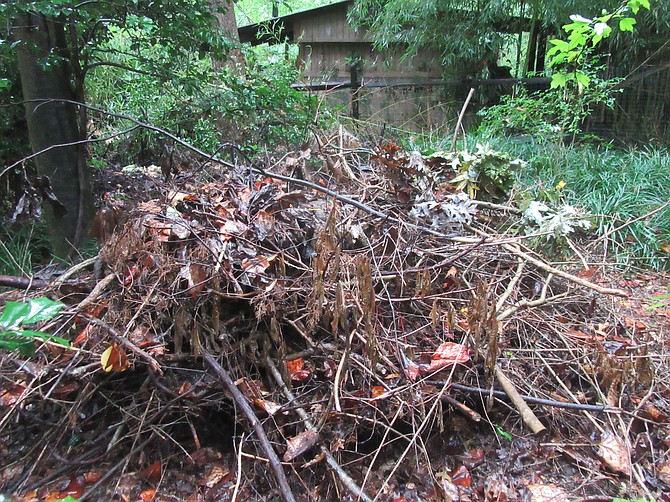Tropical storm Ophelia soaked the Washington area last weekend, leaving behind, among other impacts, fallen limbs and sticks scattered around. Instead of becoming landfill or incinerator material, they can support local wildlife, from chipmunks to chickadees.
“Brush piles are a valuable habitat component for many wildlife species, especially in areas where good natural cover is lacking,” says the Virginia Department of Forestry website. A brush pile is a mound or heap of woody vegetative material. While some may see a brush pile as an unsightly jumble of sticks, brush piles can be valuable habitat. In fact, in some places, they are called “rabbitats,” used by rabbits like our Eastern cottontail.
Among others, DOF lists these animals as using brush piles: rabbits, chipmunks, squirrels, raccoons, foxes, box turtles, gray treefrogs and many insects. Birds often use brush piles as shelter during severe weather and feed on the pile’s insects.
Brush piles can offer a safe retreat from predators, provide areas to rest, feed and shelter from bad weather and be a place to raise young. Lizards, for example, may lay eggs in the rotten wood.
As a brush pile decomposes, it helps enrich the soil. As the materials biodegrade, they provide a home for invertebrates and micro-organisms for many years. Millipedes, sowbugs and pillbugs feed on the dead plant material. Lichens may grow on wood surfaces.
Fewer trips to the landfill means reducing pollution from gas-powered vehicles. Vehicular traffic is the major source of heat-trapping greenhouse gases in Northern Virginia. Fairfax County’s data show that transportation and mobile emissions are 42 percent of all carbon emissions.
How to Build a Brush Pile
Most experts recommend starting with a sturdy base, putting the largest logs or limbs down first to create “tunnels” and air spaces. Some people use discarded wooden, untreated pallets or rocks as a base. Then just pile up branches, twigs or prunings, going from longer to shorter on top. Some recommend placing branches at different angles to form air spaces. Experts recommend not packing the materials down. Virginia DOF advises, “Effective brush piles are at least six to eight feet wide – usually larger – and at least four to six feet tall.”
Wildlife biologists urge avoiding materials that may have toxic substances, like pressure-treated lumber, lead-painted materials, tires or other petroleum-based products. A brush pile is basically just a pile of sticks.
Some people put evergreen foliage on top to create a dry place for birds to roost in the winter, especially if there are no evergreen trees or shrubs nearby. Some add discarded Christmas trees and cutback perennials and grasses. Some people grow flowering vines like trumpet honeysuckle and passion flower over their brush piles. The blossoms provide nectar for pollinators.
While some people may see a brush pile as unkempt and “messy,” incompatible with typical grassy landscapes, the piles can be tucked into a back corner, behind shrubbery or along a fence. And they cost nothing.
Here’s what Alonso Abugattas of the Capital Naturalist blog has to say: “Brush piles don’t just provide wildlife sheltering and feeding habitat, and occasionally nesting and basking sites, but also good locations to pile your leaves, branches and cuttings from your garden when you clean up. The native bees, chrysalis, cocoons, larvae and other ways that invertebrates spend the winter in them now have a safe place to overwinter and then emerge the following spring. And even if they don’t, they can feed birds and other wildlife, along with the seed heads that they may harbor. This is all part of us being a good neighbor for wildlife that is struggling to survive.”
“A brush pile is a place of life, death and regeneration,” says a Department of Forestry brochure.




